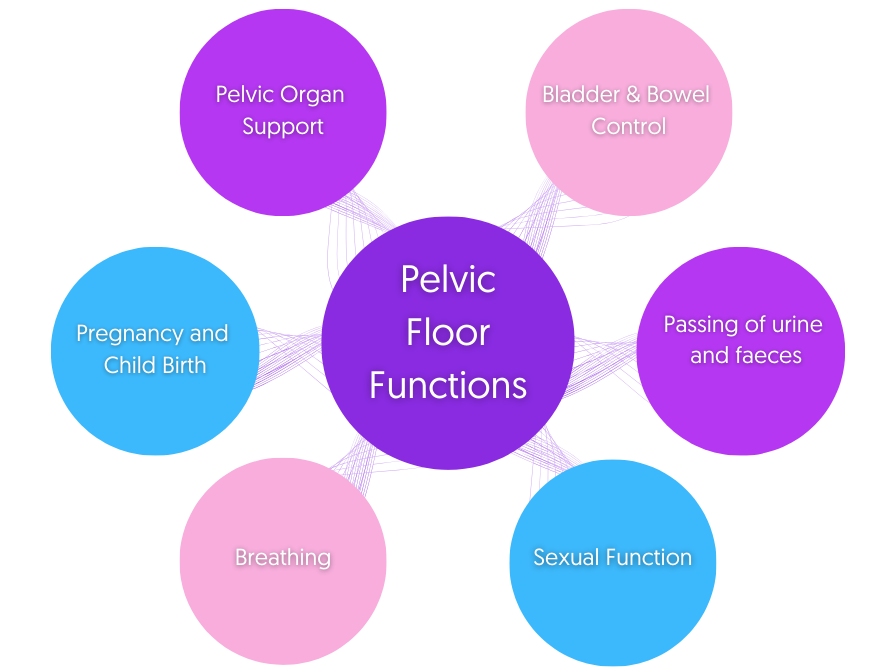The common misconception is that physiotherapy can’t help with the pelvic floor or pelvic health issues and that they’re a normal part of life when it’s the exact opposite!
The term ‘pelvic health’ describes a potential dysfunction within the organs and systems that surround the pelvic area. This can include issues with continence, sexual dysfunction, childbirth, and prostate cancer.
This blog will mainly focus on what the pelvic floor is and the different states a woman’s pelvic floor can be in.
Additionally, there will be a focus on one of the most common pelvic health dysfunctions, incontinence.

What is the Pelvic Floor?
Some researchers refer to the female pelvic floor as a lasagne, in that it has many layers. As you may have guessed, the framework that your pelvic floor is supported in is located in the pelvis. This is simply the bones of your pelvis that house the muscles, organs and ligaments.

After the pelvis, there are three different levels of muscles. Each layer of muscle has a different job whether that is controlling your bladder and bowels or helping your body prepare itself for sexual intercourse or childbirth. There are three openings of your pelvic floor, your urethra from which urine passes, your vagina the opening for sexual intercourse and childbirth and finally your anus for passing bowels.
While the lasagne metaphor works for researchers when talking about the different muscles, physios sometimes prefer to compare the pelvic floor to a trampoline. It needs to be strong, supple and flexible. If the trampoline is too stiff it can’t function properly because it’s too rigid, and if it’s too loose it will struggle to support different pressures and forces.
Different Pelvic Floor States
Our pelvic floor is a system that works in harmony with the other organ systems in our body, in fact, it is closely linked with our breathing system which is why pregnant women can feel more out of breath or have to use the toilet more frequently. The pelvic floor, like any other organ or muscle system can become tight and start to break down.
The two types of pelvic floor dysfunction are underactive and overactive pelvic floor dysfunction. While there are these two types, many women will experience aspects of both. The main symptoms of both dysfunctions are described in the table below.
UNDERACTIVE
OVERACTIVE
Lengthened
Tightened
Leakage can occur when running, jumping, sneezing
Leakage can occur when running, jumping, sneezing
Tampons or menstrual cups may fall out
Tampons or menstrual cups may be hard or painful to insert
Kegels can help but are hard to do
Kegels might make the symptoms worse and are hard to do
Sex and/or your vagina might feel different than before having kids/after birth
Penetration might be painful
You might notice a heaviness or feeling like you are sitting on a golf ball
There might be consistent groin, lower back, or hip pain
Common Pelvic Health Conditions
The term incontinence is defined as the involuntary passing of urine or faeces. Many people see it as a taboo subject or one that is normal for women to have when this just isn’t true! Just because many women suffer from incontinence does not mean you have to live with it or that you can’t improve it.
Urinary incontinence can range from leaking while taken by surprise when coughing or sneezing, to being completely incontinent of urine and needing to wear incontinence pads. Urinary incontinence can affect women of any age with many female athletes suffering from stress incontinence from potential impact training.
Faecal incontinence ranges from occasionally smearing one’s underpants to also being completely incontinent and needing to wear incontinence underwear. This kind of incontinence is common in women who have had traumatic vaginal births with severe tearing of the space between the vagina and anus.
How do we treat incontinence?
Physiotherapists can most definitely help with both faecal and urinary incontinence through supervised pelvic health rehab before, and only if necessary, resorting to surgery. With pelvic health rehab, it does take some time and it is so common to become frustrated with your rehab as it can be slow to see results however at mybod we are always here to talk and help with these frustrations.
One form of pelvic health rehab we might give you will be teaching you the ‘knack’. This is the simple term given to trying not to run to the toilet the second you get home. Many women suffer from ‘turnkey incontinence’ in that you’ve trained your pelvic floor to have to go to the toilet as soon as you get in the door.
To work through this, we would teach you to slow your breathing and to try to perform a Kegal exercise to activate your pelvic floor.

What is a Kegel and how is it done?
A Kegel is the fancy term given to exercising the muscles of your pelvic floor. How you can do this is by imagining that you are trying to prevent yourself from passing gas, so you are getting that squeeze effect in your pelvic area or you can try to lift and squeeze your vagina. While one of these options might help you, it can be incredibly common for women to use their bigger ab muscles or tense their glutes instead of their Kegels.
We typically recommend you to train or do Kegels in two ways, short and rapid pulses. This is to train the muscles that control your bladder when you sneeze or cough. This is to mimic when you are away from a toilet and need to control your bladder or bowels until you can get home. The beauty of Kegels is they can be done at any time and anywhere without anyone knowing you’re doing them!

Take Home Message
What we wanted from this blog was a chance to explain that pelvic health can be intimidating and embarrassing, but it doesn’t have to be. Your physiotherapist is here to talk through any symptoms that you have and our goal is always to try and help you live life in the best way possible.
If anything in this blog sounds familiar to you, please feel free to call into us at mybod Physiotherapy where we can discuss it further and help plan out how to help.
This blog is only a summary of the pelvic floor and if you are experiencing any other symptoms, we can help discuss how to go forward and set up a treatment plan for things such as menopause, painful periods, preparing for childbirth, postpartum, and so much more.
This blog was written by our Physio Aine Rowe who specialises in women’s health. If you would like to book in to see her, click here.


0 Comments